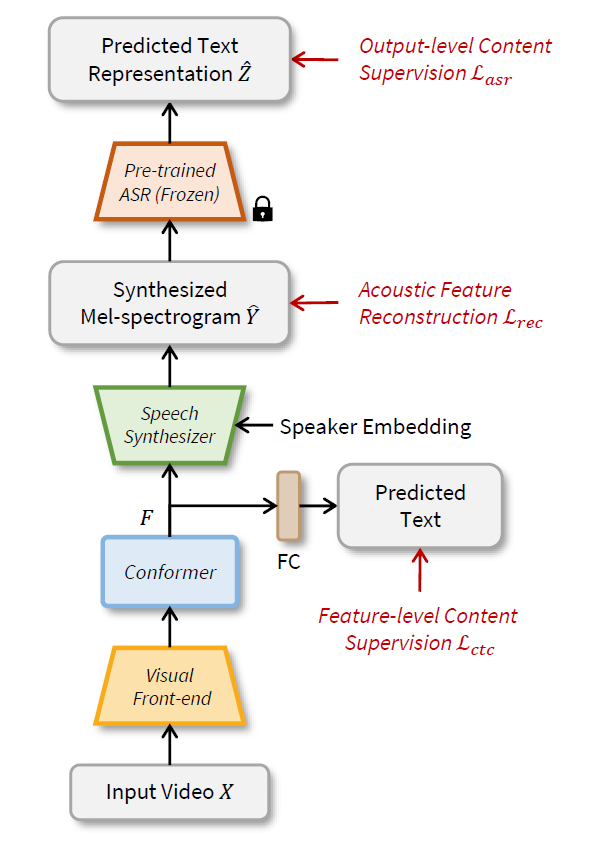This repository contains the PyTorch implementation of the following paper:
Lip to Speech Synthesis in the Wild with Multi-task Learning
Minsu Kim, Joanna Hong, and Yong Man Ro
[Paper] [Demo Video]
- python 3.7
- pytorch 1.6 ~ 1.8
- torchvision
- torchaudio
- sentencepiece
- ffmpeg
- av
- tensorboard
- scikit-image 0.17.0 ~
- opencv-python 3.4 ~
- pillow
- librosa
- pystoi
- pesq
- scipy
- einops
- ctcdecode
LRS2/LRS3 dataset can be downloaded from the below link.
For data preprocessing, download the lip coordinate of LRS2 and LRS3 from the below links.
Unzip and put the files to
./data/LRS2/LRS2_crop/*.txt
./data/LRS3/LRS3_crop/*.txt
After download the dataset, extract audio file (.wav) from the video. We suppose the data directory is constructed as
LRS2-BBC
├── main
| ├── *
| | └── *.mp4
| | └── *.txt
LRS2-BBC_audio
├── main
| ├── *
| | └── *.wav
LRS3-TED
├── trainval
| ├── *
| | └── *.mp4
| | └── *.txt
LRS2-TED_audio
├── trainval
| ├── *
| | └── *.wav
Moreover, put the train/val/test splits to
./data/LRS2/*.txt
./data/LRS3/*.txt
For the LRS2, we use the original splits of the dataset provided. LRS2
For the LRS3, we use the unseen splits setting of SVTS, where they are placed in the directory already.
Training to read sentences using CTC loss is hard to find optimization points.
We provide the visual frontend pre-trained on LRS2 and LRS3 using CTC.
When you training from scratch, it is good to initialize the visual frontend with the checkpoints below.
data_name argument is used to choose which dataset will be used. (LRS2 or LRS3)
To train the model, run following command:
# Data Parallel training example using 2 GPUs on LRS2
python train.py \
--data '/data_dir_as_like/LRS2-BBC' \
--data_name 'LRS2'
--checkpoint_dir 'enter_the_path_to_save' \
--visual_front_checkpoint 'enter_the_visual_front_checkpoint' \
--asr_checkpoint 'enter_pretrained_ASR' \
--batch_size 16 \
--epochs 200 \
--eval_step 3000 \
--dataparallel \
--gpu 0,1# 1 GPU training example on LRS3
python train.py \
--data '/data_dir_as_like/LRS3-TED' \
--data_name 'LRS3'
--checkpoint_dir 'enter_the_path_to_save' \
--visual_front_checkpoint 'enter_the_visual_front_checkpoint' \
--asr_checkpoint 'enter_pretrained_ASR' \
--batch_size 8 \
--epochs 200 \
--eval_step 3000 \
--gpu 0Descriptions of training parameters are as follows:
--data: Dataset location (LRS2 or LRS3)--data_name: Choose to train on LRS2 or LRS3--checkpoint_dir: directory for saving checkpoints--checkpoint: saved checkpoint where the training is resumed from--asr_checkpoint: pretrained ASR checkpoint--batch_size: batch size--epochs: number of epochs--dataparallel: Use DataParallel--gpu: gpu number for training--lr: learning rate--output_content_on: when the output content supervision is turned on (reconstruction loss)- Refer to
train.pyfor the other training parameters
The evaluation during training is performed for a subset of the validation dataset due to the heavy time costs of waveform conversion (griffin-lim).
In order to evaluate the entire performance of the trained model run the test code (refer to "Testing the Model" section).
tensorboard --logdir='./runs/logs to watch' --host='ip address of the server'The tensorboard shows the training and validation loss, evaluation metrics, generated mel-spectrogram, and audio
To test the model, run following command:
# test example on LRS2
python test.py \
--data 'data_directory_path' \
--data_name 'LRS2'
--checkpoint 'enter_the_checkpoint_path' \
--batch_size 20 \
--gpu 0Descriptions of training parameters are as follows:
--data: Dataset location (LRS2 or LRS3)--data_name: Choose to train on LRS2 or LRS3--checkpoint: saved checkpoint where the training is resumed from--batch_size: batch size--dataparallel: Use DataParallel--gpu: gpu number for training- Refer to
test.pyfor the other parameters
The pre-trained ASR models for output-level content supervision and lip-to-speech synthesis models on LRS2 and LRS3 are available.
| Model | Dataset | STOI |
|---|---|---|
| ASR | LRS2 | Link |
| ASR | LRS3 | Link |
| Lip2Speech | LRS2 | 0.526 |
| Lip2Speech | LRS3 | 0.497 |
If you find this work useful in your research, please cite the paper:
@article{kim2023lip,
title={Lip-to-Speech Synthesis in the Wild with Multi-task Learning},
author={Kim, Minsu and Hong, Joanna and Ro, Yong Man},
journal={arXiv preprint arXiv:2302.08841},
year={2023}
}
